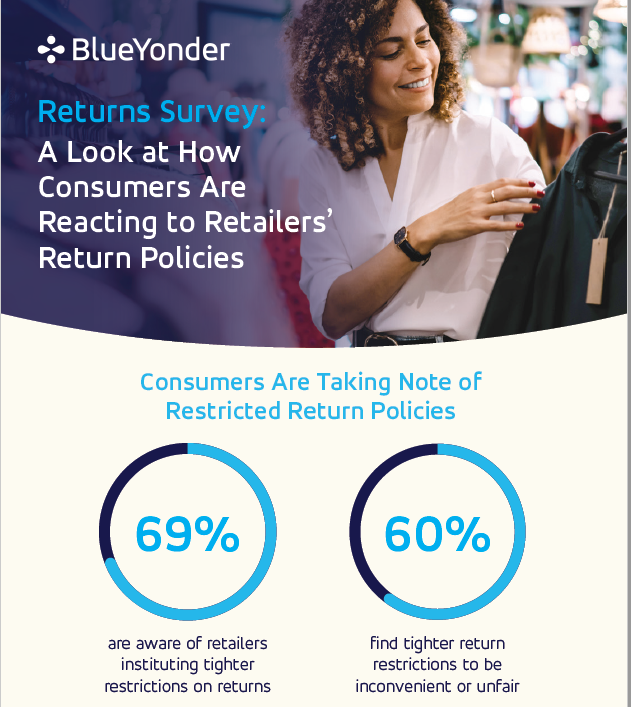How Do Consumers Feel About Retail’s Evolving Return Policies?
Consumers who have recently needed to make a return after shopping at a retailer might have noticed some extra fine print at the check-out counter. Over the past several months, many retailers have tightened their return restrictions, whether that means shortening the return window (e.g., from 60 days to 30 days), implementing restocking fees for returns, or requiring consumers to make returns in-person.
From a retailer’s perspective, adjusting your return policies is likely a sound business decision — maybe you already have excess inventory and don’t want to pay for additional product storage, or maybe you’re trying to recover some of the lost revenue associated with returns. Regardless of the reason, consumers are directly affected by this industry-wide shift, and we wanted to learn how they felt about it.
In late July, Blue Yonder asked more than 1,450 U.S. consumers to share their thoughts on the evolving landscape of retail returns. Our findings are below, along with recommendations for how retailers can maintain trust and credibility with consumers while still making the best decisions for their business.
Most Consumers Aren’t Pleased With the Changes to Retail Return Policies
A majority (69%) of the consumers we surveyed were aware that many retailers have tightened their restrictions on returns, and they didn’t view the changes favorably. More than 60% said the new policies were inconvenient or unfair to consumers. The respondents who felt differently shared that stricter return policies were fair understandable (29%), with an additional 9% noting they were okay with these restrictions if it contributes to reducing carbon emissions.
Shoppers who don’t typically return their items might be unfazed by stricter return policies, but those who do shop and return frequently have quickly taken notice.
Restocking Fees Are Most Bothersome for Consumers
Of all the new return policies retailers have implemented, instituting a restocking fee has proven to be the least popular. More than 55% of survey respondents said charging a restocking fee was the most inconvenient new policy, followed by shortening return windows (20%), restricting returns to physical locations (13%), and restricting which products can be returned (10%).
For decades, retail consumers have been accustomed to easy, free returns. The sudden shift to restocking fees for returns is a big change for most consumers, and it may stop them from spending money in the first place.
Consumer Spending Behavior May Change
Many retail shoppers research a store’s return policy before they purchase an item, and the policy may directly impact spending behavior. Stricter return policies have deterred 59% of respondents from making a purchase. Meanwhile, lenient policies were significantly or moderately influential for 71% of shoppers.
Whether purchasing apparel, footwear or home goods, consumers highly value the ability to return any items they purchase —and they may choose to return items for a variety of reasons.
Why Are Returns So Important To Retail Consumers?
Our survey respondents cited several reasons behind their retail returns, some of which were due to retailer operational challenges. A shocking 65% of respondents said they primarily returned items due to a defect or damage, while over half (51%) said they had received the wrong product altogether. Shipping speed is also key for some shoppers, with 25% saying they returned an item because it arrived after they had planned to use it.
Some of the most popular reasons behind returns have to do with consumers themselves; 77% of respondents said they made a return because their product didn’t fit as anticipated, and nearly half (49%) said they had simply changed their minds about the item.
Some savvier shoppers have used relaxed return policies to optimize their shopping; 22% said they had intentionally ordered several different sizes of an item so they could ensure finding a proper fit. Meanwhile, 11% said they purchased more than they needed just to meet the threshold for free shipping and would return the unwanted items later.
However, these savvy shopping behaviors don’t appear to be a normal occurrence for most shoppers. When asked how often they return items, 85% of respondents said every few months or less and only 10% said once a month or more.
To Optimize Shopper Experience, Retailers Should Leverage Personalization
How can this data help retailers determine the best course of action for their business? Overall, we know that most consumers are aware of and inconvenienced by stricter return policies, especially restocking fees. What’s more, consumers are likely to change their shopping behavior due to stricter policies. For retailers, what is the best path forward to keep shoppers happy?
One potential strategy is to leverage personalizationfor retail return policies. Many retailers already use a returns database to track customer information, and they can use this database to create different rules for different shoppers. For instance, if a particular shopper returns items every month or more, a retailer could begin charging that customer for every return to ensure they don’t abuse the system.
Retailers can also use the return reason as a factor in their policy. If customers return an item due to a retailer operational challenge (e.g., incorrect or defective item), the retailer could decide to relax their policies. If a return is due to consumer behavior (e.g., changed mind about product), retailers could consider implementing gentle restrictions like in-store-only returns.
Our data found that a majority (74%) of consumers always or sometimes make impulse purchasing decisions when returning items in-store. An in-store-only return policy could be a win/win approach for retailers and consumers.
To Optimize Returns Management, Retailers Should Use AI/ML-Powered Forecasting
To improve their return policies, retailers can also employ solutions to optimize reverse logistics and forecast the likelihood of returns based on historical and real-time data of the product at location level. Using probabilistic forecasts, retailers can automate decisions downstream and make predictions for items with no observed sales or return history.
Blue Yonder’s Order Management (OMS) microservice-based solutions allow retailers to determine the validation for the return, and identify the best return options, while considering the product value, distance and locations for restocking.
Blue Yonder is embracing AI/ML as a path to provide insights into high-risk customer behavior during the fulfillment stage, including those who abuse return policies. Blue Yonder’s OMS microservice solutions help retailers overcome challenges associated with returns by identifying ways to tilt the balance between customer experience and returns in favor of the store. With the right technology in place, retailers can preempt customer returns before they even happen.


